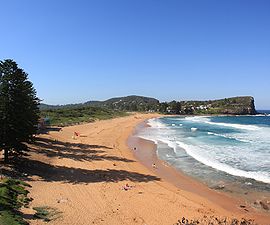
Monotoca elliptica
Encyclopedia
Monotoca elliptica, known as the Tree Broom Heath is a plant in the heath family, found in south-eastern Australia
. A long lived species which may grow for more than a hundred years.
It is often seen as a shrub of around three metres, however, exceptional specimens may reach ten metres tall. The habitat is scrub country, often near the coast on headlands and on sand dunes. A widespread plant, it is also found away from the coast and on the ranges in areas of mid to high rainfall.
Leaves are usually 10 to 25 mm long, 3 to 7 mm wide. Paler below with longitudinal leaf veins. A sharp prickle is on the leaf end. The leaf shape may be elliptic, oblong or reverse lanceolate. The leaf stem is 1 to 2 mm long and rough to touch. White flowers with red swollen anthers form in late winter and early spring on racemes. Red or orange round shaped fruit form in spring and summer, 3 to 4 mm in diameter. Indigenous Australians
used them as food. The wood was used in early colonial times for tool handles. Bark is dark, furrowed and rough.
This plant first appeared in scientific literature in the year 1793 published as Styphelia elliptica in A Specimen of the Botany of New Holland
by James Edward Smith
. It was collected by Joseph Banks
and Daniel Solander
at Botany Bay
near Sydney
in the autumn of 1770
. In 1810, the Scottish botanist Robert Brown published it in his Prodromus Florae Novae Hollandiae, as Monotoca elliptica. The specific epithet elliptica refers to the elliptical
leaf shape.

Australia
Australia , officially the Commonwealth of Australia, is a country in the Southern Hemisphere comprising the mainland of the Australian continent, the island of Tasmania, and numerous smaller islands in the Indian and Pacific Oceans. It is the world's sixth-largest country by total area...
. A long lived species which may grow for more than a hundred years.
It is often seen as a shrub of around three metres, however, exceptional specimens may reach ten metres tall. The habitat is scrub country, often near the coast on headlands and on sand dunes. A widespread plant, it is also found away from the coast and on the ranges in areas of mid to high rainfall.
Leaves are usually 10 to 25 mm long, 3 to 7 mm wide. Paler below with longitudinal leaf veins. A sharp prickle is on the leaf end. The leaf shape may be elliptic, oblong or reverse lanceolate. The leaf stem is 1 to 2 mm long and rough to touch. White flowers with red swollen anthers form in late winter and early spring on racemes. Red or orange round shaped fruit form in spring and summer, 3 to 4 mm in diameter. Indigenous Australians
Indigenous Australians
Indigenous Australians are the original inhabitants of the Australian continent and nearby islands. The Aboriginal Indigenous Australians migrated from the Indian continent around 75,000 to 100,000 years ago....
used them as food. The wood was used in early colonial times for tool handles. Bark is dark, furrowed and rough.
This plant first appeared in scientific literature in the year 1793 published as Styphelia elliptica in A Specimen of the Botany of New Holland
A specimen of the botany of New Holland
A Specimen of the Botany of New Holland, also known by its standard abbreviation Spec. Bot. New Holland, was the first published book on the flora of Australia. Written by James Edward Smith and illustrated by James Sowerby, it was published by Sowerby in four parts between 1793 and 1795...
by James Edward Smith
James Edward Smith
Sir James Edward Smith was an English botanist and founder of the Linnean Society.Smith was born in Norwich in 1759, the son of a wealthy wool merchant. He displayed a precocious interest in the natural world...
. It was collected by Joseph Banks
Joseph Banks
Sir Joseph Banks, 1st Baronet, GCB, PRS was an English naturalist, botanist and patron of the natural sciences. He took part in Captain James Cook's first great voyage . Banks is credited with the introduction to the Western world of eucalyptus, acacia, mimosa and the genus named after him,...
and Daniel Solander
Daniel Solander
Daniel Carlsson Solander or Daniel Charles Solander was a Swedish naturalist and an apostle of Carl Linnaeus. Solander was the first university educated scientist to set foot on Australian soil.-Biography:...
at Botany Bay
Botany Bay
Botany Bay is a bay in Sydney, New South Wales, a few kilometres south of the Sydney central business district. The Cooks River and the Georges River are the two major tributaries that flow into the bay...
near Sydney
Sydney
Sydney is the most populous city in Australia and the state capital of New South Wales. Sydney is located on Australia's south-east coast of the Tasman Sea. As of June 2010, the greater metropolitan area had an approximate population of 4.6 million people...
in the autumn of 1770
First voyage of James Cook
The first voyage of James Cook was a combined Royal Navy and Royal Society expedition to the south Pacific ocean aboard HMS Endeavour, from 1768 to 1771...
. In 1810, the Scottish botanist Robert Brown published it in his Prodromus Florae Novae Hollandiae, as Monotoca elliptica. The specific epithet elliptica refers to the elliptical
Ellipse
In geometry, an ellipse is a plane curve that results from the intersection of a cone by a plane in a way that produces a closed curve. Circles are special cases of ellipses, obtained when the cutting plane is orthogonal to the cone's axis...
leaf shape.
Regeneration & Cultivation
Slow and difficult to grow from seed, though after 18 months, some seeds should germinate. Cuttings may be a better option. This plant may be used in hedges. A tough and adaptable plant which responds well to pruning.

